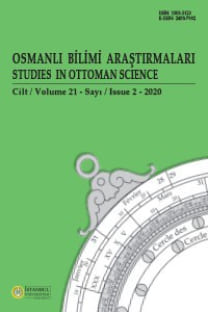Osmanlı’nın ilk jeoloji kitabı ve Osmanlı’da jeolojinin durumu hakkında öğrettikleri
Osmanlı İmparatorluğu’nda yayımlanan ilk Türkçe jeoloji kitabı İlm-i Tabakatü’l Arz (Istanbul, 1853) olup, bu kitap, Nérée Boubée’nin Geologie Populaire à la Portée de Tout le Monde Appliquée à l’Agriculture et à l’Industrie (Paris 1833) adlı popüler nitelikteki eserinin Kahire’de yapılan Arapça tercümesinden Türkçe’ye çevrilmiştir. Osmanlı devlet adamlarının bu kitaba yazdıkları öygü dolu takrirler, Osmanlı yöneticileri ve entelektüellerinin Avrupa’daki bilimsel gelişmelere büyük ilgi duyduklarını gösterdiği gibi, Avrupa’da jeoloji konusundaki gelişmelerden habersiz olduklarına da işaret etmektedir. Bu bildiri, Géologie Populaire’in Ali Fethi Efendi’nin Ali Fayid’in Al-Aqwâl al-Murdiya fî ’ilm Bunyat al-Kura al-Ardiyya (Boulaque, 1842) başlığını taşıyan Arapça tercümesinden yaptığı Türkçe çeviriyi incelemektedir. Türkçe çevirinin Arapça ağırlıklı dili, onun Türk okur arasındaki popülaritesine engel teşkil etmiş olmalıdır. Bu çeviri, aynı zamanda modern bilimin yalnızca Avrupa dillerinden çeviriler ile değil, Arapça metinler üzerinden de Türkiye’ye girdiğini göstermektedir. Diğer taraftan, esere, Sultan I. Abdülmecid’in iradesi ile devlet matbaasında basılmasına izin verilmiş olmakla birlikte, basım masraflarının mütercim tarafından karşılanmış olması, çeviri projesinin devlet in değil, fakat kişisel girişimle gerçekleştiğine işaret eder.
Anahtar Kelimeler:
Jeoloji, jeoloji tarihi, İlm-i Tabakatü’l Arz, Nérée Boubée, Mehmed Ali Fethi Efendi, Ahmed Fayid, Osmanlı’da doğa bilimleri
The first geology book published by the Ottomans and what it teaches on the state of geology in the Ottoman Empire
The first independent book in Turkish on geology published in the Ottoman Empire was İlm-i Tabakatü’l Arz (Istanbul, 1853). It was a translation made from the Arabic of a popular book originally published in French in Paris by Nérée Boubée under the title Geologie Populaire à la Portée de Tout le Monde Appliquée à l’Agriculture et à l’Industrie (Paris 1833). The great importance placed on this book by the Ottoman dignitaries, shows that although there was an enthusiasm for Western science among the administrators and the intelligentsia, they were unaware of the scientific developments in geology in Europe. The present paper focuses on the Turkish translation of Géologie Populaire made by Ali Fethi Efendi from Ali Fayid’s Arabic translation titled Al-Aqwâl al-Murdiya fî ’ilm Bunyat al-Kura al-Ardiyya (Boulaque, 1842). An analysis of the Turkish translation shows that all technical terms were borrowed from the source text in Arabic. The artificially elaborate Ottoman constructions in the text, not reflecting the simplicity and the elegance of the original, may have been one obstacle in its increase of popularity among Turkish readers. This translation is a particular case pointing out that the introduction of modern sciences to Turkey did not only occur through direct translation from European textbooks but through their popularized versions in Arabic translations as well. Although printed at the imperial printing house with the permission of Sultan Abdülmecid I, the printing expenses were covered by the translator himself, a fact assessing the individualistic character of the translation project.
Keywords:
Geology, history of geology, İlm-i Tabakatü’l Arz, Nérée Boubée, Mehmed Ali Fethi Efendi, Ahmed Fayid, Natural Sciences in the Ottoman Empire.,
___
- -
- ISSN: 1303-3123
- Yayın Aralığı: Yılda 2 Sayı
- Başlangıç: 1995
- Yayıncı: İstanbul Üniversitesi Edebiyat Fakültesi
Sayıdaki Diğer Makaleler
Osmanlı donanma gemilerinin ilaç sandıkları: Ondokuzucu yüzyıl başına ait bir araştırma
Asuman Baytop'un Özgeçmişi, Botanik Gezileri, Bitki Koleksiyonu, Kitapları, Yayın Listesi
Osmanlı eczacılığında bir kilometre taşı: İngiliz Eczanesi, İstanbul
Türkiye bitkileriyle ilgili bazı gelenekler, törenler ve inançlar
Osmanlı İmparatorluğu’nda Afyonun Tarihi
Türkiye’de Diş Hekimliği Eğitim ve Öğretimi (1908-1933)
Ali BALTACIOĞLU, İsmail BALTACIOĞLU
Osmanlı’nın ilk jeoloji kitabı ve Osmanlı’da jeolojinin durumu hakkında öğrettikleri
Hüsnü Demiriz (1920-1999) ve Türkiye Bitkileri Koleksiyonu
Osmanlı eczacılığının gelişme sürecinde ilaç hazırlayıp satan esnaf ve sağlıkçılar
